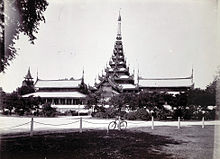比亞達
缅甸建筑的分层塔顶
比亞達(緬甸語:ပြာသာဒ် IPA:[pjaʔθaʔ] pyatthat)是梵語प्रासाद(prāsāda,意為建於高台上的神廟)的緬甸語音譯,在緬甸建築中指分層的塔頂,分三至七層不等,均為奇數層[1]。比亞達是緬甸奘寺和宮殿的常見特色[1]。



構造
編輯每一層的底座為長方形,立面傾斜,呈金字塔形。層與層之間由一盒子形狀的結構相接,稱萊包(လည်ပေါ် lebaw)[1]。每層均有金色鑲邊,為金屬板雕,四角有尖狀裝飾,稱為杜因(တုရင် du yin)。比亞達的最頂端是木製塔尖,稱丹布(တိုင်ဖူး taing bu)或貢布(ကွန်းဖူး kun bu)。
比亞達依照層數(ဘုံ boun)區別分為三類,三層、五層和七層塔分別名為亞馬(yahma)、杜巴(thooba)和杜亞馬(thooyahma)[2]。
歷史
編輯比亞達是緬甸建築歷史悠久的特色,起源於蒲甘王朝時期[3],阿難陀寺和高杜巴林寺都有分層塔構造。
比亞達式塔頂具有神聖意義,常見於王室建築和佛寺[4],王宮大殿修有七層塔尖,前六層象徵六欲天[5],頂層象徵著婆羅門教宇宙觀念的須彌山頂(မြင်းမိုရ်)[6]。
圖冊
編輯-
曼德勒敏東王陵
-
曼德勒王宮宮門
-
曼德勒王宮
-
曼德勒的御舟
參見
編輯參考文獻
編輯- ^ 1.0 1.1 1.2 Hla, U Kan. Pagan: Development and Town Planning. Journal of the Society of Architectural Historians. 1977, 36 (1): 15–29. JSTOR 989143. doi:10.2307/989143.
- ^ Scott, James George. The Burman, His Life and Notions. BiblioBazaar. 1910: 126. ISBN 978-1-115-23195-4.
- ^ Strachan, Paul. Imperial Pagan: art and architecture of Burma. University of Hawaii Press. 1990. ISBN 978-0-8248-1325-3.
- ^ Fraser-Lu, Sylvia. Burmese Crafts: Past and Present. Oxford University Press. 1994. ISBN 9780195886085 (英語).
- ^ Ferguson, John. Essays on Burma. Brill Archive. 1981: 53. ISBN 978-90-04-06323-5.
- ^ Michael, Aung-Thwin. Heaven, Earth, and the Supernatural World: Dimensions of the Exemplary Center in Burmese History. Journal of Developing Societies. 1986, 2. ProQuest 1307834694.
- ^ Tilly, Henry L. Wood Carving Of Burma. Burma: Superintendent, Government Printing. 1903.
- ^ Nisbet, John. Burma Under British Rule--and Before. A. Constable. 1901 (英語).